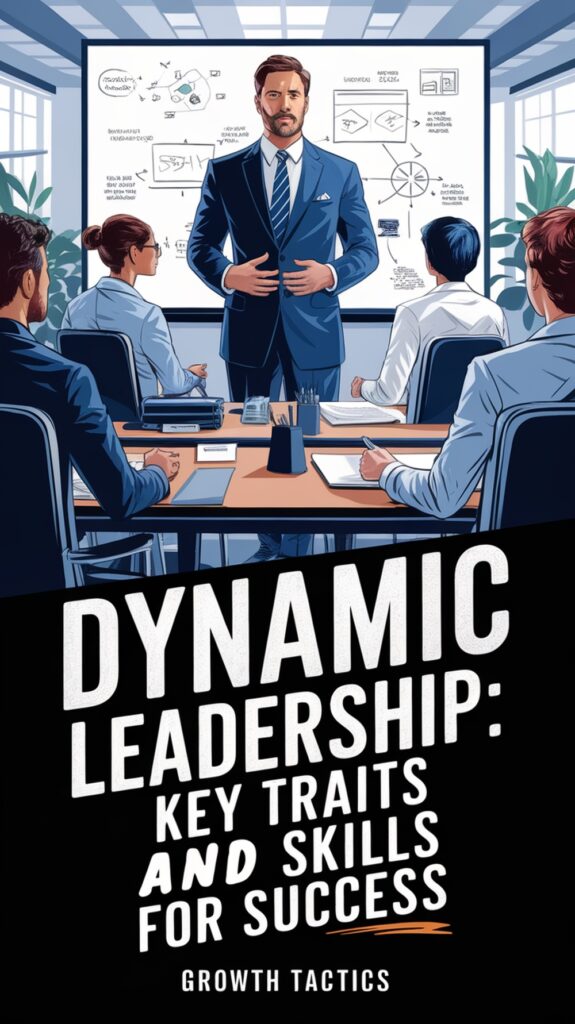Dynamic leadership involves leading teams and organizations with adaptability and a bold vision. It focuses on the need to be able to pivot quickly in dynamic environments.
In today’s fast-moving business scene, leaders have to read the room, switch gears, and keep every teammate engaged.
Want to find out what distinguishes dynamic leaders from their peers and how you can be one?
Let’s get right into it!
Jump To Section
What Defines Dynamic Leadership Today?

Flexible leadership emerges as the true X-factor in our roller coaster of a world today. We’re living in a world of permanent change, hybrid work today, new technology tomorrow. Dynamic leadership is about being able to navigate various work environments and situations.
It’s not enough to have a “playbook” of skills; you need to know when to deploy them as well! Adaptability, resilience, and flexibility are no longer negotiable. They’re at the heart of what it means to lead today.
More Than Just Being Flexible
Flexibility is a critical element of leadership today. It’s about feeling the mood, balancing the trade-offs, and making smart, tactical decisions, especially when the going gets tough.
Leaders who survive and flourish in this environment aren’t just responsive, they’re proactive. They understand the right times to advocate for change and the right times to dig in their heels.
Thriving in Nonstop Change
Leaning in to change means thriving, not just surviving. In nonstop change, thriving beats surviving.
Smart leaders with a growth mindset are always on the lookout for opportunities to get ahead of the change, not just keep up with it. They aren’t just waiting for a major crisis to hit before they take bold action.
Rather, they create an environment where all voices are invited to help shape, pivot, and innovate. When organizations open up and allow more perspectives into the dialogue, everyone involved has their power amplified and their spirits lifted.
Traits of a True Dynamic Leader

Adaptive leaders are made for the unknown. They provoke debate, maintaining a willingness to listen more than they speak, and encourage their teams to tell stories, including the ugly ones. By taking this inclusive approach, you foster trust and ensure everyone is prepared to tackle whatever is next.
Let’s discuss some of the characteristics you can work on if you want to be a more dynamic leader.
High Adaptability Quotient (AQ)
Adaptability Quotient, or AQ, is the measure of how easily someone adapts to change. In today’s world, where challenges pop up faster than afternoon thunderstorms, high AQ matters more than ever. Think of a manager who smoothly transitions her team from in-person to remote work without skipping a beat.
That’s AQ in action. Leaders with high AQ keep their teams engaged when plans shift and stress mounts, often leading to higher job satisfaction. They treat uncertainty as a puzzle, not a threat.
If you’re looking to sharpen your AQ, it starts with honest self-reflection and practice. Take on new roles, seek feedback, and learn from every curveball.
Visionary Yet Practical Approach
Dynamic leaders definitely dream big, but they never just drift away into the ether. They’re visionary but practical, like an architect working from blueprints to build the world’s tallest building. By marrying the visionary approach with practical steps, they leave room for imagination but, most importantly, keep the team on task.
Here, learning is ongoing, and everyone’s ideas are equally welcome.
Empathy Paired with Decisive Action
Empathy involves really tuning in. Truly listening, not just waiting for your chance to speak. Dynamic leaders gauge the whole of their team, knowing what motivates and concerns people. Empathy paired with decisive action is a game changer.
Making the hard calls, even the unpopular ones, is exactly what dynamic leaders do. This combination of empathy with tough-mindedness builds trust, and trust is necessary to keep teams pushing up the mountain.
Courage to Challenge the Norm
Lasting impact comes from leaders who question the obvious and try new paths, even if it means swimming against the current. Courage enables smart innovation and pushes teams to come back even tougher following defeat.
By taking intelligent risks, reflecting on what went well and what didn’t, and always pushing the envelope, complacency should never set in.
Core Skills for Dynamic Leadership

Adaptive leadership isn’t only about leading in smooth waters, it’s about being able to sail through rough seas as well.
A dynamic leader’s playbook is not a cookie-cutter approach! It’s core skills that’ll make you feel like you can pivot on a dime, empower others to act, and keep growing. Regardless of what comes at you today.
So what are these core skills?
1. Making Agile, Informed Decisions
Having the ability to make agile, informed decisions is often the difference between building momentum and losing it for a team. Dynamic leaders understand that there is never perfect clarity. They consider the best information at hand and take action. Adjusting as new data comes in.
2. Communicating for Real Connection
Effective communication ensures all of your team members are rowing in the same direction. Open dialogue and transparency build trust within the team, something that is crucial to one another during turbulent times.
Be a manager that is always available, present, deeply listens and share your own wins and failures. It’s that honesty which creates deep engagement and loyalty, especially when the waters are stormy.
3. Sparking Innovation, Managing Risk
Innovation flourishes where risk is managed, not eliminated. You need a little bit risk for innovation to happen. Dynamic leaders foster experimentation, and that includes tolerating failure, since every misstep offers a fresh lesson.
4. Using Tech and Data Smartly
Smart leaders lean into technology and analytics. Whether it’s using data dashboards to spot trends or automating workflows, keeping up with tech advances means better, faster decisions.
5. Building Empowered, Flexible, and Resilient Teams
Empowered, resilient teams weather storms much more effectively. Dynamic leaders create cultures of support, recognize accomplishments large and small, and promote a constant cycle of learning.
By celebrating what was accomplished and reinvesting in their development, they foster loyalty and a desire to stay prepared for what’s next.
How to Make a Real Difference as a Dynamic Leader

A dynamic leader does not seek accolades for the sake of accolades; they seek influence, not power.
What’s more, every day, they are rolling up their sleeves and bending the arc of outcomes by learning from every meeting, conversation, and challenge. Real impact? It shows up in the way teams run smoother, goals are met (or surpassed), and cultures become places people want to stay.
Fostering a Flexible Team Culture
Your team’s culture begins with leadership. When leaders model inclusion and positivity, it’s contagious. For instance, a supervisor might begin staff meetings by passing on good news.
By creating a space where everyone can share their own perspectives, the room instantly becomes a safer, more dynamic environment. Aligning the values of your team with the organization’s greater mission is crucial.
It’s the glue that helps every person and team pull in the same direction! If teams are to become dynamic, then they need leaders who model the dynamic behavior that they expect.
Just like change efforts, leaders need to talk the talk, but more importantly, walk the walk in every interaction, even when no one’s looking!
Leading Through Turbulent Times
When the world gets turned upside down (and, let’s face it, it always does), dynamic leaders don’t retreat behind closed doors. They arrive, present and grounded.
What breeds stability is having consistent, straightforward communication; no sugarcoating, even when the news is bad. As many experienced during the pandemic, leaders who checked in consistently fostered a sense of connection among their teams.
A simple “How are you doing?” allows you to be visible and available. You never know how much information you can gain just from simply initiating the conversation. It isn’t just a courteous gesture, it’s imperative to get out there and listen to your people.
Fueling Long-Term Business Growth
Dynamic leaders don’t just go for short-term solutions, they plant seeds. They chart long-term courses, understanding that growth is not a race.
By investing in training and mentoring, future leaders are continually developed to step in. When everyone’s learning and trying new things, resilience is built.
That’s how organizations weather the storms.
Avoiding Common Pitfalls in Dynamic Leadership

This type of leadership can be very intriguing, dynamic, fast meetings, big showy moves, and a lot of narrative about being innovative. Here’s the catch: it only works when there’s real substance under all that energy.
Employees don’t want just anyone. They need someone who really listens, someone who’s relatable, someone who’s not just “on” when the other people are watching. Ever sat through a meeting where the leader dominates with flashy ideas but nobody’s quite sure what the actual goal is? That’s a big red flag. Without that shared north star, teams flounder, their focus and direction waver, and engagement is lost. It’s like steering a ship through dense fog without navigation tools.
A second common dynamic leadership pitfall is the pull to micromanage the work. Leaders often assume that hands-on means dynamic. Data continues to suggest otherwise. Nearly 70% of people have thought about quitting because of micromanagement.
When you micromanage, people disengage. Real, authentic engagement requires that you trust other people to take ownership of their work, rather than always having to be in their business. It’s easy to get into that “hero leader” mindset, thinking you need to solve all the issues on your own, but it’s not always best in the end.
Cultivate Your Dynamic Leadership Style
Dynamic leadership can’t be achieved by going down a cookie-cutter checklist. Instead, it’s about developing a style that fits who you are, what your organization values, and the unique challenges you face.
Here are some ways you can cultivate your :
Commit to Lifelong Learning
Leaders who remain inquisitive and continue to educate themselves, through formal classes, industry conferences, or informal exchanges with colleagues, never fall behind.
It’s not just about getting your next credential, but learning new ways of thinking that sharpen your skillset. Being up to date is not only a good idea, it’s a requirement. The better informed you are, the more agile you are when the world decides to pull a fast one on you.
Embrace Diverse Viewpoints Actively
Dynamic leadership is about listening to everyone’s voice. Hearing from someone you’ve never shared a table with before may instantly spark some innovative thinking.
Looking for ideas beyond your regular orbit supercharges that creative process! By bringing in diverse perspectives to address issues from all sides, you’ll sharpen your solutions and make your team more innovative.
Practice Mindful Self-Reflection
Taking time to understand yourself, what gets you stuck, and what inspires you goes a long way. Leaders who practice the art of self-reflection are better able to identify blind spots and manage their ego.
Mindfulness isn’t a catchphrase, it’s a tool that allows you to slow down, hear out, and craft an appropriate response, particularly when tensions run high.
Seek Mentorship, Offer Guidance
Mentorship makes good leaders great. Both hearing from others’ journeys and sharing what you’ve learned with those coming up behind you will hone your craft and expand your network.
It’s a win-win. When everyone teaches, everyone learns.
Conclusion
What’s the bottom line on dynamic leadership? It’s not about being the smartest person in the room or having all the answers. It’s less about checking boxes and more about establishing trust, learning as you go, and taking risks.
Dynamic leaders are the ones who roll with those changes, keep their team calm, and stay curious, not rigid. One thing I have learned is that no two leaders are alike. The most successful ones show up with a sense of empathy, openness, and flexibility, and a deep desire to learn.
Forging a new path of growth happens when we remain receptive and attentive. That’s the essence of dynamic leadership, and it’s a skill anyone can develop, one courageous action at a time.


